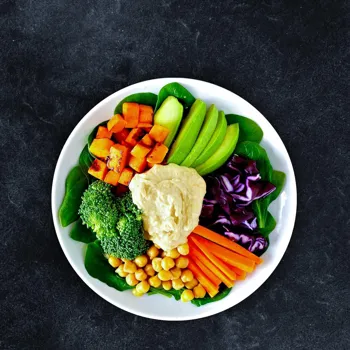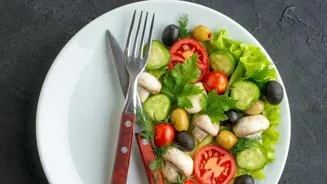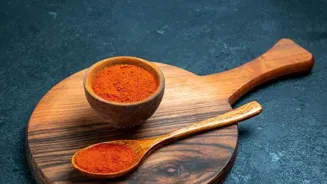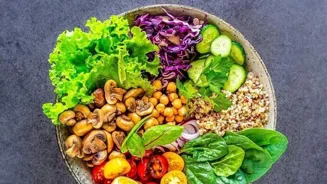Unlock the secrets of mindful eating with these 6 practical tips. Dive in and master portion control effortlessly!
In today’s fast-paced life, where instant noodles and takeaway meals are the norm, keeping
a check on our portions can feel like climbing Mount Everest. But hold on, it's not as daunting as it seems!
Portion control is simply about being mindful of how much we're eating, and it's a fundamental aspect of maintaining a healthy weight and overall wellbeing, especially relevant in India where festivals and family gatherings often involve delicious, generously served food.
Let’s explore some simple yet effective tips to help you master the art of portion control and embrace mindful eating.
Start with Swapping Your Plates and Bowls:
Think about it, the size of your plate directly influences the amount of food you pile on. Using smaller plates and bowls is a surprisingly effective trick to automatically reduce your portion sizes. Our brains are wired to perceive a full plate as a satisfying meal.

So, by using a smaller plate, you trick your brain into feeling content with less food. Trade those huge dinner plates for smaller salad plates, and switch to smaller bowls for your dals, curries, or even those delicious helpings of kheer during festive times.
It's a subtle change, but it can make a significant difference to your overall calorie intake. Remember, it's all about visual perception! Also think about using a plate that is designed with healthy portions, it might help you with control.
Read Food Labels like a Pro:
In India, we love our packaged snacks and ready-to-eat meals, but these can be loaded with hidden calories and surprisingly large serving sizes. The first step is to actually read the food labels before you pop anything into your mouth.
Pay close attention to the serving size listed and compare it to how much you actually intend to eat. You might be shocked to discover that what you perceive as a single serving is actually two or even three! Doing this will give you the exact carbs, fats, and protein you are consuming.
Consider using a food scale to accurately measure your portions, especially when consuming less healthy items. Over time, you'll develop a better understanding of appropriate portion sizes.
Serve Food from the Kitchen, Not at the Table:
This is a classic trick that many health-conscious families swear by. Instead of placing all your yummy dishes on the dining table, serve your portions directly from the kitchen onto your plate. This prevents you from reaching for second helpings out of habit or social pressure.
When food is readily available in front of you, it's much easier to mindlessly grab another serving. Serving in the kitchen can help improve portion control. It requires you to be more intentional and mindful about how much you're eating.
This will also help you avoid wasting food, as you're only serving what you intend to eat. This prevents temptations from being directly visible to the view.
Use your Hand as a Guide:
Measuring cups and scales aren't always practical, especially when you are eating out or traveling. That's where your own hand comes in handy! Your hand can be a surprisingly accurate portion guide. For example, a serving of rice or lentils (dal) should be about the size of your cupped hand.
A portion of any vegetable is the size of a fist. Keep these visual cues in mind when dishing up your meals, and you'll be able to eyeball portion sizes with much greater accuracy. This method is simple, convenient, and readily available wherever you are.
Just remember this shouldn’t be used with packaged food. This also helps in tracking your portions with healthy foods.
Eat Slower! Savor Every Bite:
We Indians generally eat fast due to our hectic lives. One of the simplest yet most effective ways to practice portion control is to slow down your eating speed. Take your time; chew each bite thoroughly and savor the flavors.
It takes about 20 minutes for your stomach to signal to your brain that you're full. By eating slowly, you give your body a chance to catch up, preventing you from overeating. Put your fork down between bites, engage in conversation, and simply focus on the experience of eating.
You'll be surprised at how much less you need to feel satisfied. Slow eating improves digestion as a bonus! Try not to eat while busy with another activity, that can increase portions.
Hydrate through out:
Drinking plenty of water throughout the day has tons of benefits, including aiding in weight management. Sometimes, we mistake thirst for hunger, leading us to eat when we don't actually need to.

Before reaching for a snack, drink a glass of water and wait a few minutes to see if your hunger subsides. Additionally, drinking water before meals can help you feel fuller and eat less. A cup of water, a light snack or a warm cup of tea can reduce the quantity of your meal.
Choose water, or healthy drinks instead of sugary drinks. Sometimes drinking green tea with no sugar can reduce your cravings for some foods.
AI Generated Content. Glance/InMobi shall have no liability for the content









